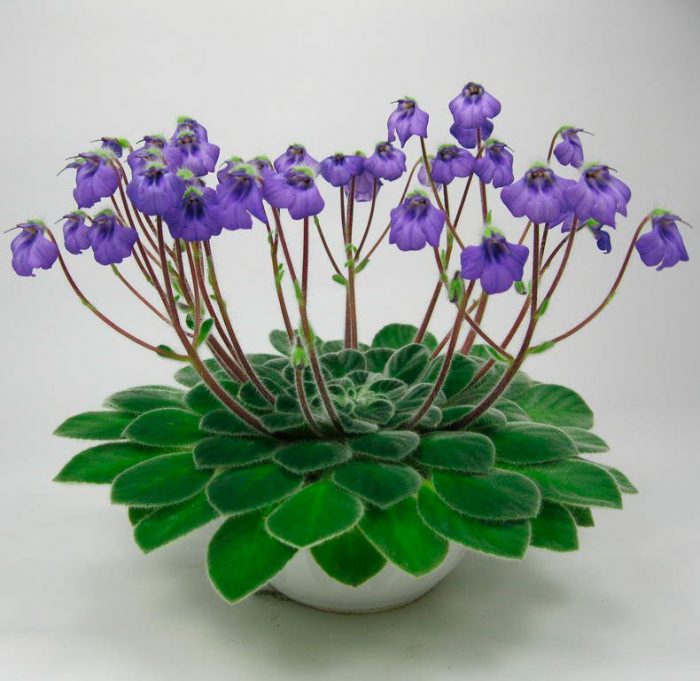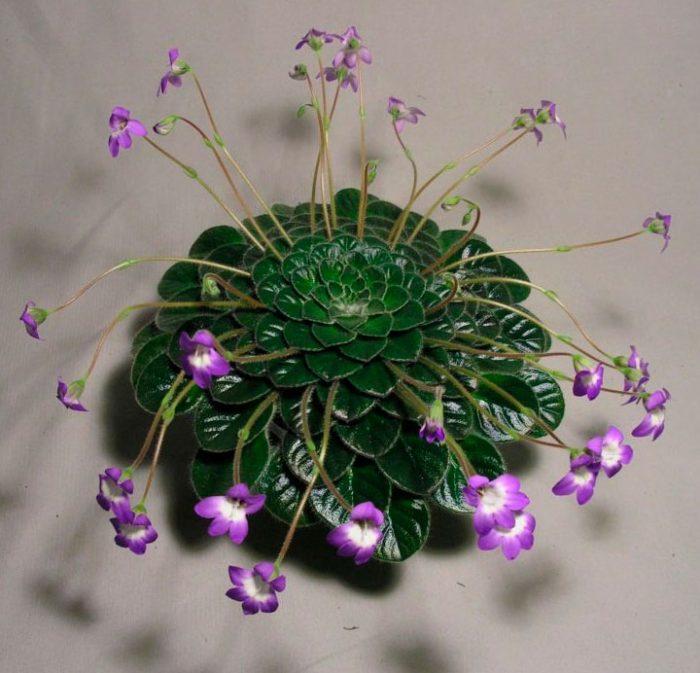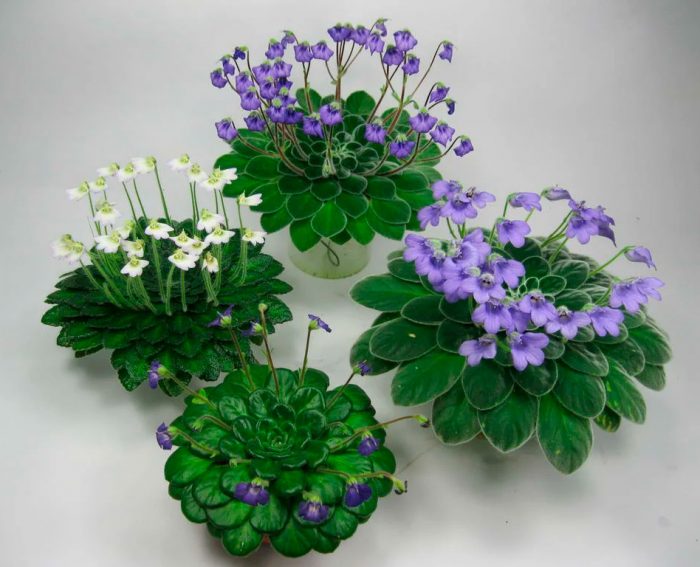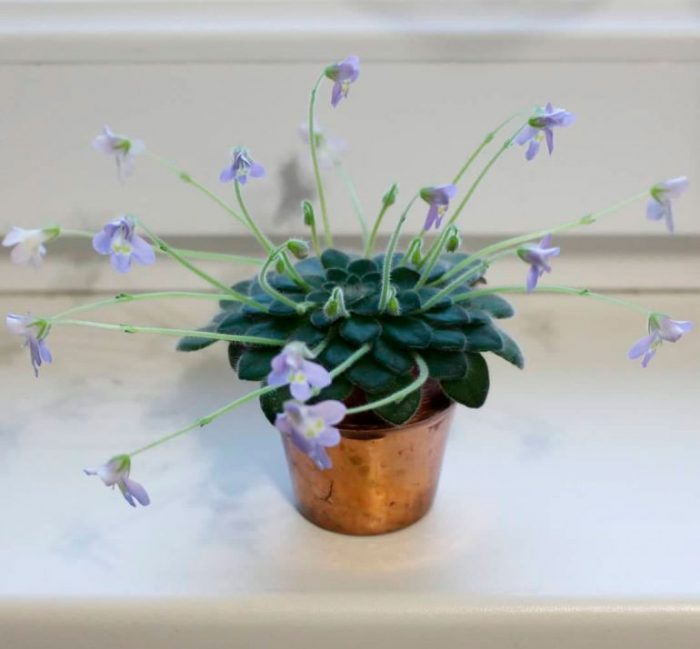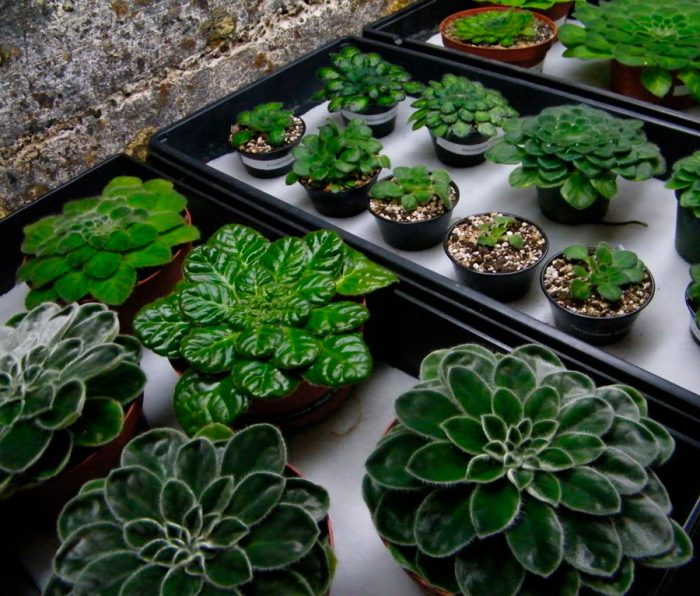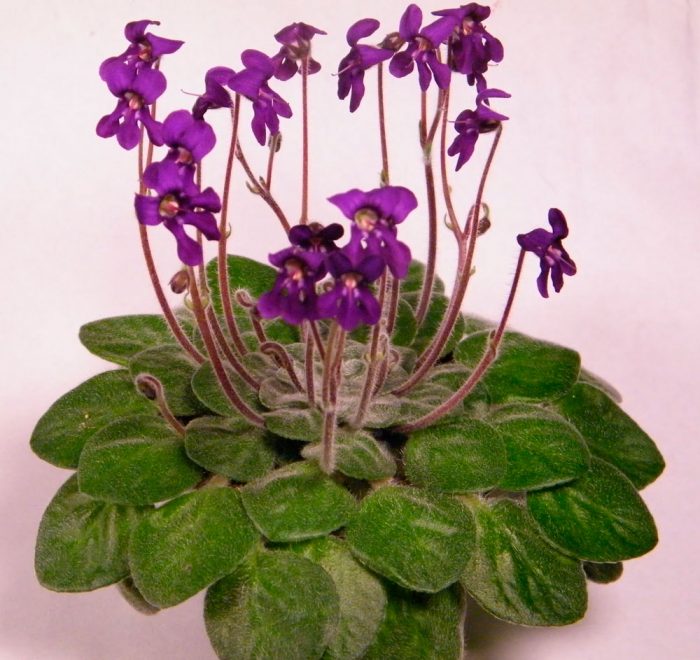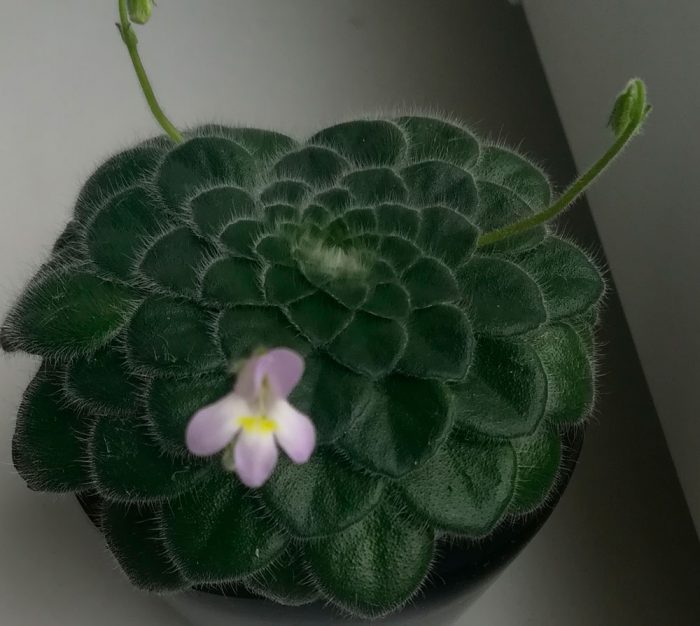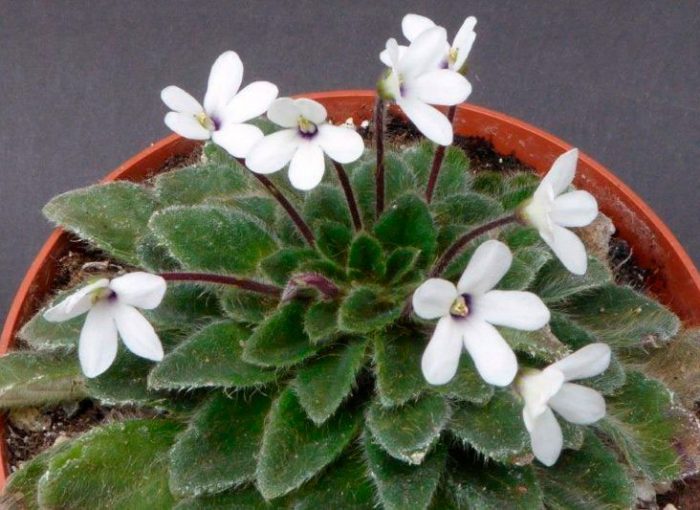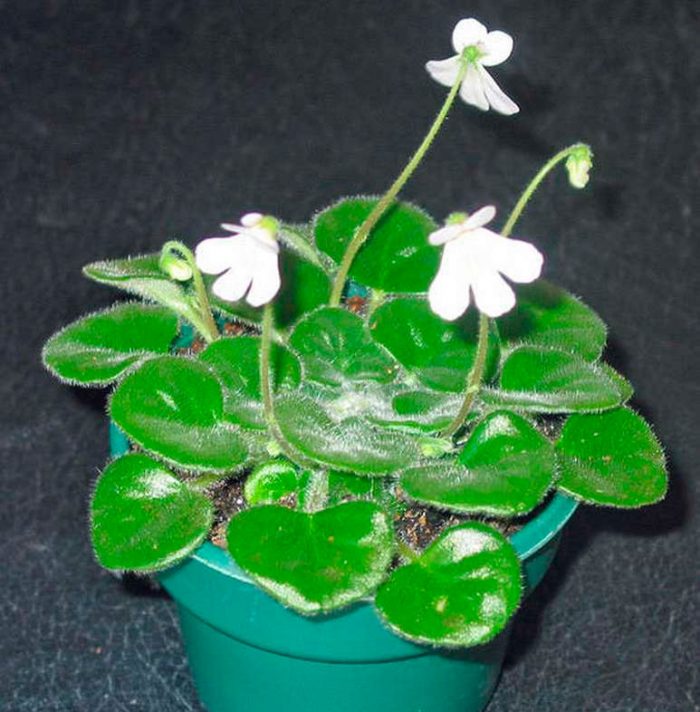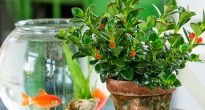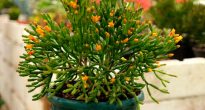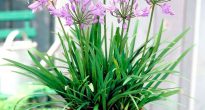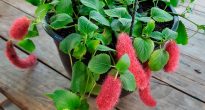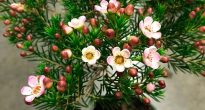The herbaceous compact perennial plant Petrocosmea is part of the Gesneriaceae family. This genus unites about 30 species, most of which externally differ noticeably from each other. This plant comes from China. Over time, it became widespread in the highlands, as well as moist forests in Southeast Asia.
All species of this plant have a distinctive feature: short petiolate small leaf plates with a velvety surface grow in tiers and form a dense dense rounded rosette. The leaf plates can be cordate, oval or elongated, and their surface can be smooth or have dense pubescence.
If you create optimal conditions for growth petrocosm, then it will bloom for almost the whole year. Long stalks grow out from under the leaves. On their tops, delicate flowers are formed that look like a forest violet.
Petrokosmey is quite difficult to grow indoors. Therefore, it is more suitable for an experienced florist. The plant is slow growing and has a lifespan of 2 to 3 years.
Content
Brief description of cultivation
- Temperature... During the growing season, the air temperature can vary from 18 to 22 degrees. During the rest period, it should be from 15 to 17 degrees.
- Air humidity... High humidity is required. It is forbidden to moisten the bush from the sprayer. Wet expanded clay is poured into a deep pallet, and a pot with a flower is placed on top.
- Illumination... Light is needed diffused. Grows well under an artificial light source or in a shaded place.
- Watering... Moisten the soil mixture in the pot moderately and immediately after the top layer dries.
- Earth mix... Should be light and well drained. You can use a commercial soil mixture for Saintpaulias, in which it is recommended to add a little dolomite flour or lime. For self-preparation of the soil mixture, it is recommended to combine perlite (sand), garden soil and humus (peat) (1: 1: 1).
- Fertilizer... During the growing season, the flower is fed once every 30 days with liquid complex mineral fertilizer for indoor plants.
- Transfer... Only if absolutely necessary. It is carried out no more than once every couple of years.
- Reproduction... Leaf cuttings, seed method or dividing rosettes.
- Care features... It is impossible to rejuvenate the bush, because it does not grow stems. It cannot be moistened with a sprayer; instead, the flower is given a warm shower.
Petroscomeia care at home
Bloom
If you take good care of the room petrocosme and provide it with suitable conditions for growth, then it will delight with its flowers throughout almost the whole year. The formation of inflorescences occurs at the tops of long peduncles, while they can include from one to several small flowers. Outwardly, they are very attractive and similar to the forest violet. Flowers can be painted in a variety of shades of blue, blue, white, pink or purple.
Temperature
Such a plant feels best in a cool environment. The optimal air temperature in the room for its maintenance during the growing season is from 18 to 22 degrees. Remember that the room where Petrokosmeya is located should be no colder than 10 degrees and not hotter than 25 degrees. With an excessive increase in temperature, the flowering of the bush will stop. During the rest of the petrocosm, it is necessary to provide a cool content at a temperature of 15 to 17 degrees.
Air humidity
Such a spectacular flower needs high humidity. However, in no case should it be moistened with a spray bottle. The fact is that in those places where droplets of water fall on the surface of the velvety foliage, stains and specks of yellow color appear. Therefore, it is recommended to spray not the bush itself, but the air around it. At the same time, make sure that droplets of liquid do not fall on the leaves.
Illumination
The plant does not need a lot of light. It grows well and develops well even in shade. You can also decorate the western, eastern and northern windowsill with petrocosm. Remember that the bush needs protection from direct sunlight.
In the event that the bush is in shade, it is recommended to systematically turn the pot a little around its axis. As a result, a symmetrical growth of the rosette of leaves will be observed. And for a long active flowering of petrocosme, it is necessary to provide additional lighting in the autumn-winter period.
Watering
This spectacular plant is undemanding to watering. For him, a particular danger is the stagnation of moisture in the soil mixture. The fact is that if the roots are constantly in a humid environment, then this can lead to their decay.
Be very careful when moistening the soil mixture in the pot, as if water droplets fall on the surface of the foliage, yellow spots may form on it. The regularity of watering depends on the degree of drying of the substrate in the pot. It is recommended to moisten the substrate only after its top layer dries out to a depth of about 15 mm.
Pot selection
When choosing a pot, attention should be paid to the root system of the plant. It is rather weak and small in Petrocosm. In this regard, the pot should be chosen low and small. For a young bush, you need to choose a pot with a diameter of 50 to 70 mm, and for an adult - from 110 to 140 mm. If the bush is old and has grown a lot, then a container is chosen for planting it, the diameter of which corresponds to the size of the rosette of leaves.
Soil mixture
This flower grows and develops normally in a ready-made substrate for Saintpaulias, which is sold in specialized stores. However, it is imperative to add an incomplete handful of dolomite flour or lime to it.If you want to prepare the soil mixture yourself, then combine perlite (coarse sand), humus (peat) and garden soil in a 1: 1: 1 ratio.
Fertilizer
Top dressing of petrocosme is carried out only in the spring-summer period with a frequency of 1 time in 30 days. To do this, use a liquid complex fertilizer for indoor plants. Please note that ½ part of the dosage recommended by the manufacturer is used to prepare the nutrient solution.
Petrocosme transplant
This plant reacts extremely negatively to transplanting, since it does not like when its root system is disturbed. In this regard, such a procedure is carried out only when it is necessary, for example, if the substrate is completely depleted. Remember that you can transplant a bush no more than 1 time in 2 years.
The transplanted plant stops developing for several weeks. In order for the adaptation to be easier and faster, it is recommended to put the pot together with the transplanted bush in a plastic bag to create the most favorable conditions for growth.
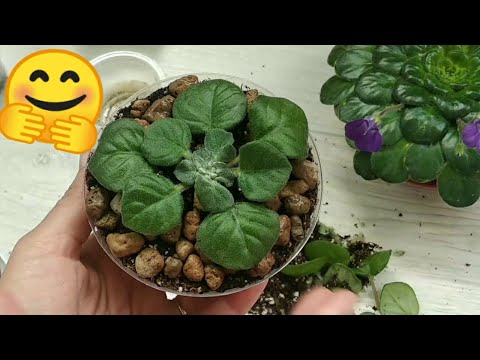

Watch this video on YouTube
Pruning
It is not necessary to cut off indoor petrocosm, as it does not form shoots and stems. However, in order for the bush to always look neat, do not forget to promptly cut off the injured leaf plates and the flowers with peduncles that have begun to fade.
Dormant period
This plant does not have a pronounced dormant period. But in the autumn-winter period, it has a slowdown in growth and development due to the shortening of the length of daylight hours. During the dormant period, it is recommended that the petrokosmeya be kept in a cooler place (from 15 to 17 degrees), as well as provide it with more rare and meager watering, while preventing the earthen coma from completely drying out.
Reproduction methods
Growing from seeds
Fill a bowl with light soil mixture and sow petrocosme seeds on its surface. Moisten crops from a spray bottle and cover with foil or glass on top. Do not forget to systematically ventilate the crops, and also, if necessary, moisten them with a sprayer.
If the bowl is placed in a cool place, then the seedlings will appear much faster, but their growth and development will be slow. As the plant grows, it is subjected to a pick twice, and then seated in separate containers.
Cuttings
You can propagate a flower with leaf cuttings. At the beginning of spring, cut a few leafy cuttings from an adult bush. At the same time, a petiole of no more than 15 mm should be left for each cutting. For rooting, the leaves are placed in a container with water or planted in a fertile soil mixture. In order for the cuttings to give roots as quickly as possible, they are placed in a mini-greenhouse.
The appearance and active development of children is observed after about 6 weeks. They are not separated from the parent bush. After the cutting has lush foliage, it is simply planted in a separate small pot.


Watch this video on YouTube
Possible problems
With room petrocosm, problems can arise if the rules of care are regularly violated or it is not provided with favorable conditions for growth. For example:
- The appearance of rot on the root system... This can happen due to an overly dense and heavy soil mixture or due to frequent, abundant watering. Remove the bush from the pot, cut out any rotted roots and plant it in a new potting soil.
- Spots of yellow on foliage... They are formed due to the ingress of water droplets on the surface of the leaves, provided that the bush is in direct sunlight. Never spray a flower with a spray bottle.
- Yellow foliage... An excess of nutrients is observed in the soil mixture, the air humidity in the room is too low, or the bush has been in direct sunlight for a long time.
- Drying of the tips of the leaf plates... The air in the room is very dry.To increase the humidity, the bush together with the pot is placed on a pallet filled with wet expanded clay. Petrocosmey can also be grown in a special florarium.
- Pests... Mealybugs, scale insects, whiteflies, spider mites and thrips can settle on the bush. To get rid of pests, the flower is treated with a suitable acaricidal or insecticidal agent.
Types of petrocosmeis photos and names
Petrocosmea flaccida (Petrocosmea flaccida)
Large teardrop-shaped leaf plates of a greenish hue are part of a geometrically regular rosette, which has a flat shape. Single small flowers are painted in a rich dark purple color.
Petrocosmea Forrest (Petrocosmea forrestii)
The compact leaf rosette has a perfectly regular shape. It consists of bright green leaf plates with dense pubescence on the surface. On the petals of pale lilac flowers, there are specks of yellow and white.
Petrocosmea Kerri (Petrocosmea kerrii)
In this natural species, the low rosette consists of large, long-peaked, rich green leaf plates that have an elongated shape. The petals of small flowers are purple-white.
Petrocosmea barbata (Petrocosmea barbata)
The compact graceful rosette consists of semicircular emerald green leaf plates, on the surface of which there is pubescence. The petals of white-silvery small flowers have small yellow spots.
Petrocosmea formosa
Heart-shaped bright green leaf plates with a velvety surface are part of a loose rosette. This variety is distinguished by rather large flowers, the lower petals of which are pale lilac, and the upper ones are light pink.


Watch this video on YouTube

